Why the constant alertness? This is deemed necessary to guard against surprise attack. The flight time of a submarine-launched missile targeting Washington DC is less than 15 minutes. During that time warning systems would need to detect the launch and move up the chain of command to alert the president. The president would therefore have little time in which to evaluate the attack and respond. During those few minutes he would have to determine if the threat was valid and authorize a response. Thus all nuclear protocols are based on extremely quick reaction times with no room for doubt or error. The president of Russia is under the same time constraints as is the premier of China. Other world leaders with nuclear arsenals operate under similar constraints.
Once orders are given, electronic command signals would go out to airfields, land-based missile bases and submarines. These military assets might themselves be destroyed in a few minutes. Thus it's necessary that they react the moment the command is received. This system is made possible by a complex distributed early-warning and command-and-control system.
Due to the extreme alert level and overall complexity of the system, there are been many false alarms and close calls over the years. These have taken many forms. Often it seems like good luck was the only thing that prevented disaster.
Given our simulation involves a Russian attack, here are two example close-calls involving their forces:
On September 26, 1983 Russian defenses detected five incoming ICBMs. In fact these ICBMs were computer-generated phantoms, but the Russians didn't know that. As a result alarms went off in a command bunker near Moscow. This bunker was the last stop. If it validated the signal then an emergency We-Are-Being attacked message would have gone straight to the Kremlin. The pressure was intense and the system was positive in its assessment of the ICBMs. However the commander of the bunker decided - by instinct - that it was a false alarm. He over-ruled the computers. Had that not happened there was only last step before Russia launched a counter-attack.
Another example. On January 25th, 1995 the Norway launched a meteorological rocket. That by itself was routine. Indeed, routine paperwork was filed alerting other countries. Unfortunately not everyone got the memo. The Russians were surprised and their air-defense went on full alert. To their computer this meteorological rocket appeared to be an attack by a US submarine. Launch orders actually reached the desk of the Russian president. At one point they were just a few minutes from launching a full-scale retaliatory attack. This was avoided only because the Norwegian rocket flamed out over the sea.
Lest we think only Russians have problems with nukes, we should briefly note that the United States has had its share of incidents as well. Consider the notorious Damascus Incident. Never was there a better example of Murphy's Law.
A workman was doing routine maintenance at an ICBM silo in Arkansas . He dropped his wrench. The wrench punctured the missile's fuel tank. Fires started and one thing led to another until eventually the missile tried to launch itself. Fortunately only the second stage ignited, which detonated the rocket shortly after liftoff. In this fashion Arkansas failed to incinerate Moscow. However the sheer force of the blast also blew the missile's 9 megaton thermonuclear warhead straight into the air. It landing just outside the base's front gate. Had it exploded it would have devastated and irradiated a large part of Dixie. Worse, its impact could easily have led US defenses to believe that an attack was underway.
A dropped wrench, a computer error, some mislaid paperwork - on a planet packed with 15,000 warheads wired to hair-trigger computer systems, it doesn't take much to bring on doomsday.
But the situation is even worse than that, as history amply demonstrates that it doesn't necessarily take an accident to start a war. 9 countries possess the means to destroy the world. That in itself is an inherently unstable arrangement. Every state must watch ever state, all the time and with never a miscommunication. In such an environment it is easy for a miscalculation or a mistake to get out of hand. Or for an unstable leader to simply make a bad call. This is why - for instance - that the world takes such interest in who becomes president of the United States. The U.S. president can order a nuclear attack at any time and for any reason. There are no safeguards. Thus it's imperative the president be psychological and emotionally stable, as the fate of the planet rests in that person's hands. The same goes for the leaders of the other nuclear powers.
This is the world we live in: one filled with nuclear weapons primed to fire at a moment's notice. Our physical survival demands that no person and no computer ever makes a nonrecoverable error. Thus our lives are constantly on a knife-edge, just one turn of the key away from oblivion. All it takes is bad leadership or a good leader having a bad day. Or a series of unlucky or accidental events. Or simply a random psychopath who in the wrong place at the wrong time.
But what would an attack actually look like?
It's hard to comprehend the brutal scale and destructiveness of a modern weapons. To help in this regard let's look at some visualizations.
The "Little Boy" bomb that destroyed Hiroshima had a yield of 15 kilotons (15kt). In other words, the bomb's explosive power was equivalent to 15 thousand tons of TNT. This single weapon killed over 140,000 people. Partly from the force of the explosion itself, but mainly from the severe burns that tens of thousands of people suffered.
There have been hundreds of nuclear tests over the years. Therefore we have a good mathematical handle on how to calculate their direct effects. For this simulation I use the well-known scaling equations found here.
So how destructive are these weapons? Let's answer this in a modern context by attacking Los Angeles with Little Boy. For such urban areas it's optimal to air-burst the weapon high above the target. Exploding the weapon at a suitable altitude maximizes the weapon's destructive reach. In contrast, surface-bursts are used to destroy more difficult targets. These include military structures and command bunkers, but also naturally hardened structures such as airport runways and dams. A surface-burst digs a crater, whereas an air-burst channels this energy instead towards a greater area of destruction.
So let's drop Little Boy on Los Angeles. We'll detonate it 2,000 feet over the target. The resulting blast pattern looks like this:
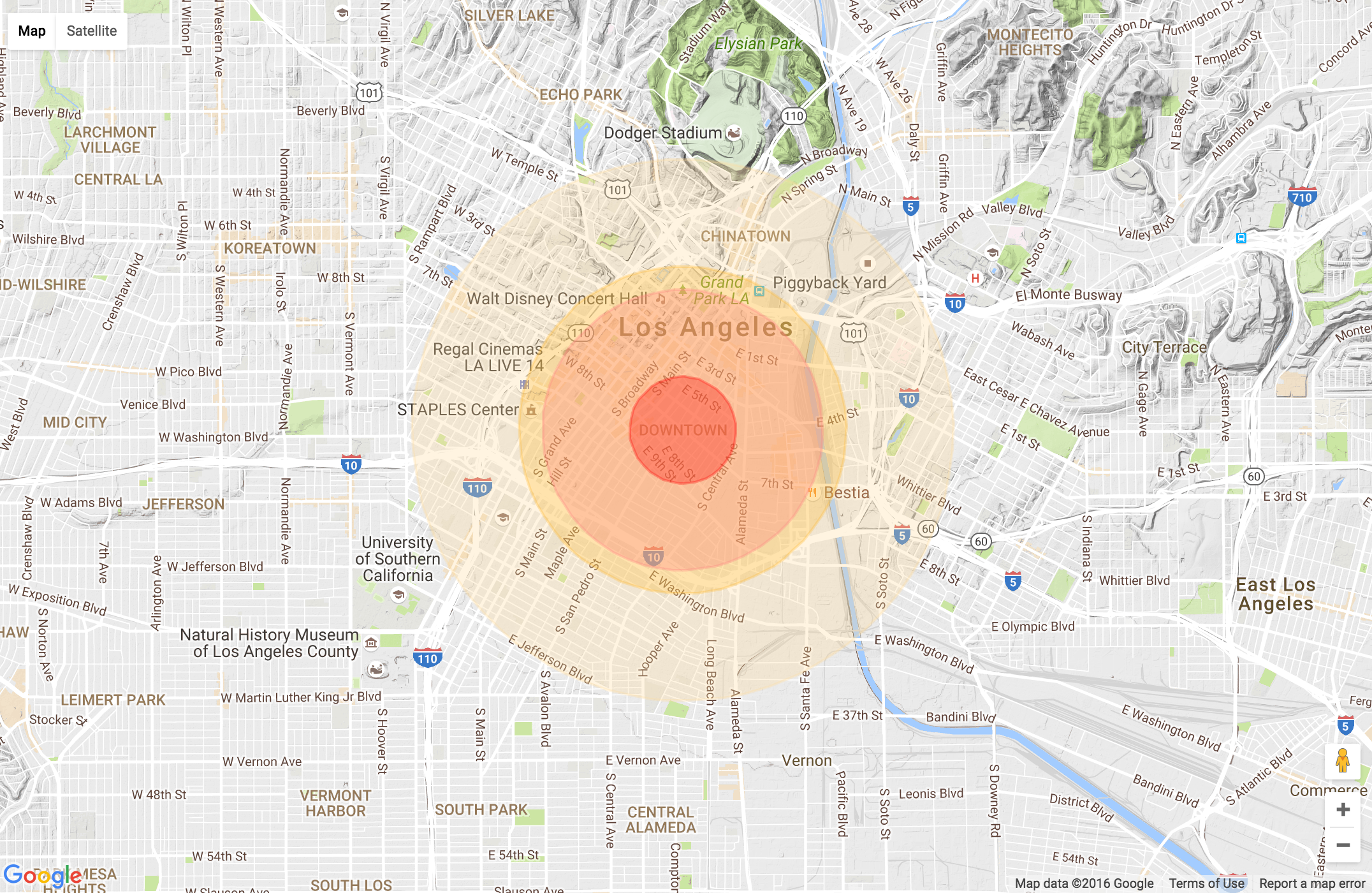
Four nested circles centered on ground zero illustrate the bomb's key effects. The inner red circle is the 20 psi zone. Here the blast wave would exceed 20 pounds per square inch - a truly enormous pressure. 20 psi is enough to take down a skyscraper. Lethal gamma radiation would also flood the area while temperatures would spike to many thousands of degrees. This is a true overkill zone.
For this attack the 20 psi circle extends outward 0.42 miles from ground zero. Few if any will survive.
The 2nd ring marks the 5 psi area. Here concrete buildings are blown out and scorched rather than vaporized or leveled. Temperatures and radiation decline, although gamma radiation will still be lethal in the inner parts of the ring. Some people will survive. However virtually all these survivors will be severely injured by burns, shrapnel and radiation. In Los Angeles this area extends 1.12 miles from ground zero.
The 3rd ring marks the lethal thermal area. Here anyone exposed to the blast will suffer 3rd-degree burns. Without prompt medical attention such burns are generally deadly. The blast wave will also remain powerful enough to damage wooden structures and blow out windows. At least half the population will be injured or killed. This ring extends 1.29 miles from ground zero.
The last ring marks the extent of the non-lethal burn area. Here the blast has lessoned to a mere hurricane and so the main threat is the pulse of heat. Anyone caught in the open will suffer 1st or 2nd-degree burns. Some people will also be blinded, their retinas permanently scarred by the incredible burst of light. There would be many such injuries and some deaths, from burns and shrapnel. This ring extends to 2.5 miles from ground zero.
Overall this bomb would directly affect 20 square miles of LA.
Blast, radiation and heat are just the first effects. In addition, fires would ignite throughout the target area. These would spread and merge. Under proper conditions such fires self-feed, becoming firestorms that suck in oxygen for surrounding areas and burn everything that can possibly burn. Many people might survive the initial attack only then to be trapped and incinerated by the resulting inferno.
All of these effects add up to a catastrophe. Hitting LA with a weapon like Little Boy would be a unparalleled disaster. This one bomb would kill hundreds of thousands of people.
Now let's consider modern weapons. These bigger bombs make Little Boy look like a firecracker. For example, the American B83 has a yield of 1.2 megaons - 80 times more powerful than what we just dropped on LA. But even that weapon isn't anywhere near the maximum. The Chinese Deng-Feng 5 delivers 5Mt. And the Russians possess a 20Mt weapon (currently inactive, thankfully).
Here is Little Boy vs LA again, but with the map zoomed out:
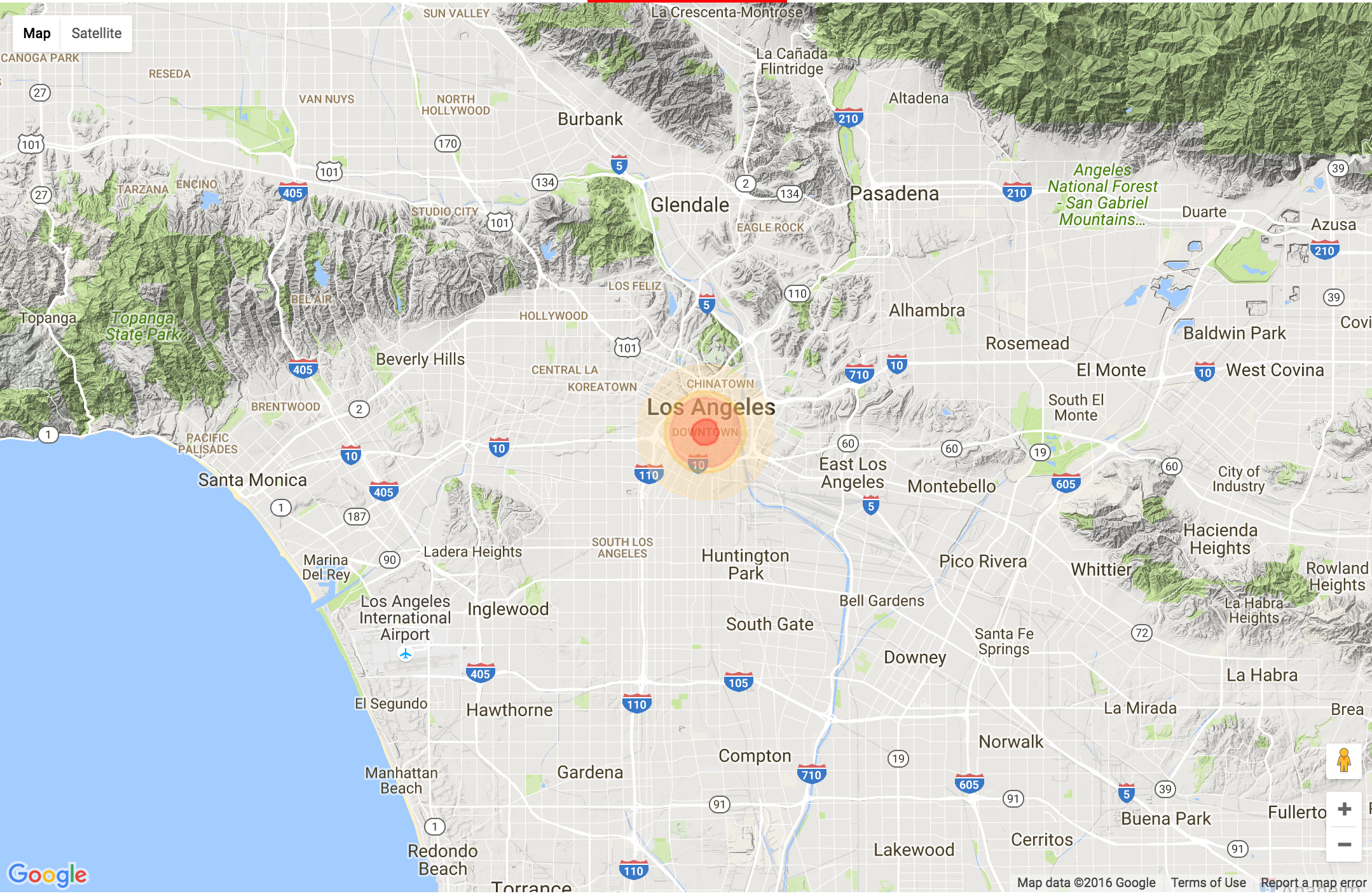
Holding that zoom constant, let's now drop a Deng-Feng on the same unlucky spot:
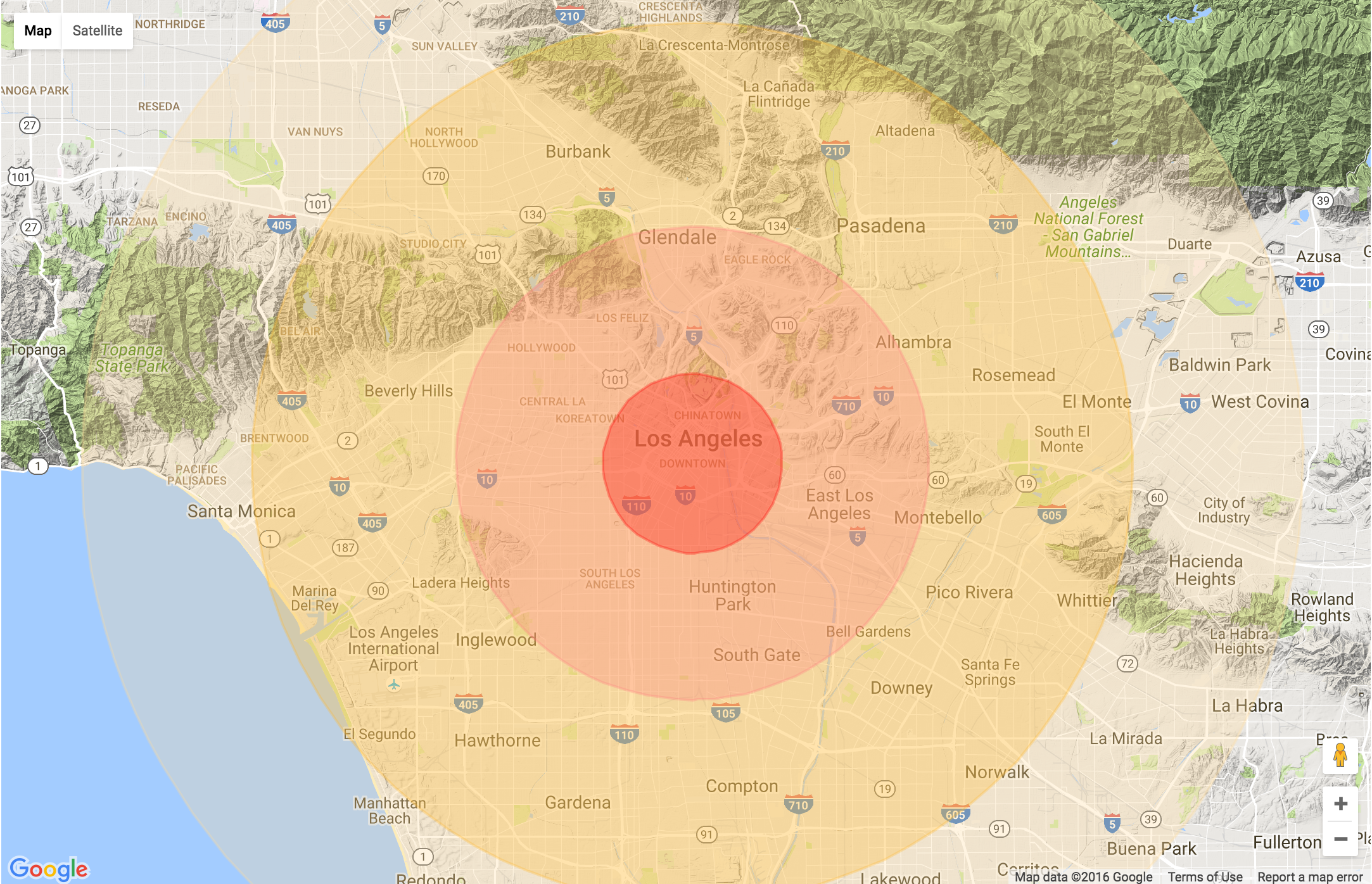
Because of the increased yield we detonated this weapon at 16,000 feet.
We see the same effects as before, except the the affected areas are now simply enormous. The central 20 psi no-survivor zone extends 2.78 miles from ground zero and the 5 psi ring extends for 7.34 miles. People would be blinded and burned 20 miles from ground zero- all the way out into the Pacific Ocean. Gigantic firestorms would engulf much of the LA basin. The total blast area would exceed 1,200 square miles. Millions would die.
All this from a single bomb.
Fallout is pulverized radioactive ground material that has been blasted into the air by the mushroom cloud. These irradiated particles are then carried onwards by the high-altitude prevailing winds, generating a lethal plume that can extend for hundreds of miles downwind. Eventually this plume rains down back to earth, bringing the radioactivity with it. The effects of that can range from the inconsequential to the lethal, contingent on intensity and length of exposure.
Fallout is measured in a variety of ways, depending on what aspect you want to measure. Given we're interested in the biological damage that radiation causes, we will use the sievert (Sv). This unit is generally expressed in milli-sieverts (mSv) or micro-sieverts (uSv). Geiger-counters typically measure in uSv per hour.
People respond differently to radiation. What makes one person slightly sick to their stomach might outright kill another. But as a basic guide, a dose of 500mSv is the first danger point. At that dosage signs of radiation sickness appear: headaches, nausea and vomiting. You won't die, although you might become so miserable as to prefer it.
Bigger doses induce worse symptoms. A dosage above 1,000mSv brings the first fatalities and a dosage above 3,000mSv leads to a 50% death rate. Anything above 10,000mSv is invariably lethal. It won't be a good way to go, as the effects are gruesome.
A single-dose of radiation is more deadly than the same dose spread out over time. For instance, say you are considering a walk through a fallout zone. Your Geiger counter registers 3,000mSv in this area. That means that if your walk lasts one hour you would get a total dosage of 3,000mSv. That's easily enough to kill you. In contrast, if your Geiger counter registered 3mSv, you could spend 1,000 hours outside before getting the full 3,000mSv dose. In that case your chances of survival would be higher given the dosage accumulated more slowly.
To get a sense of scale, yearly exposure in the United States averages around 6mSv. A dental X-Ray is .01mSv and eating a banana costs you .0001mSv. As of 2015 the inside of the Fukushima reactor core was burning at 9,700mSv (9.7sV). Health tip: do not step inside a damaged nuclear reactor core.
So how much radiation would a bomb produce? And where would it fall?
Compared to measuring the effects of bomb blast and heat, this calculation isn't so easy. There are a variety of complicating factors that have to be taken into account.
First, the physics of the weapon itself regulates the amount of radiation produced. Fission produces radiation much more so than fusion. Modern weapons are fusion-based, however they require fission as their means of ignition. They are in effect two bombs in one: an initial fission bomb to get fusion reaction going, followed by the explosion of the thermonuclear fusion device itself. The energy released by the fission ignites the resulting fusion reaction. Therefore the degree of radiation produced is partly a function of how much fission is in the weapon. This is called the fission fraction and it varies across weapon designs.
The amount and intensity also varies due to the mode of targeting. Because the fireball from an air-burst doesn't reach the ground, relatively little surface material gets thrown into the stratosphere. Thus an air-burst on a non-military target won't generate much fallout. A surface-burst is a different matter. It interacts with the ground by design, throwing up countless tons of irradiated soil. Attacks on missiles sites and command posts can generate plumes encompassing enormous areas. Airports and other infrastructure (ports, dams, railway junctions) can get hit with surface-bursts as well, generating similar amounts of fallout.
Fallout is also a function of wind and weather. Ground-level winds will carry some fallout locally. However this is a relatively minor effect, particularly given that area will have already suffered from the blast, heat and intense localized gamma radiation. The fallout plume themselves depend on high-altitude winds. These can pick up the cloud and carry it for long distances. In fact, they will carry some level of fallout around the planet. These high-altitude winds blow in certain prevailing directions, but they also seasonally shift and interact with other weather patterns. These shifting winds make fallout calculations imprecise.
There are further complexities. For instance, surface composition affects the type of material and level of radiation. A surface-burst in a sandy desert will behave differently than one in an urban center. Local weather conditions may bring some fallout down as rain. Other meteorological effects generate hot spots. These can crop up anywhere, bringing down a lethal dose to an area that would otherwise not be fatally affected by the fallout.
There is also the question of target outliers. What would happen if a nuclear reactor was hit by a surface-burst? Reactors store an immense amount of radioactivity. That's why nuclear-disaster sites such as Chernobyl and Fukushima will remain uninhabitable for some time. A nuclear strike on a reactor would unleash this radioactivity and irradiate an immense area of the country.
For all these reasons, it's not possible to plot fallout with 100% confidence. Unlike other nuclear weapon effects such as pressure and heat, the best we can do is an approximation.
Thus for this simulation I chose a simple and conservative model. I ignored the possibilty of target outliers (such as reactors) and I chose the most-prevalent wind-patterns for each target. To map the fallout plumes themselves I used Carl Miller's Simplified Fallout Scaling System. Based on atmospheric test data from the 1950s, this provides a simple average way to map the fallout contours. I chose to map the area exceeding 10mSv (10,000uSv). At that base rate, 2 days of exposure would bring on the start of radiation sickness. After 2 weeks of exposure people would begin to die.
As you move deeper into a plume the radiation and the the threat level rises. One can use Miller's model to plot these higher radiation levels at more detail, but this probably implies a greater precision to the model than is warranted by the data. Thus I chose to keep the calculations simple and modest and limit them to 10mSv/hour.
Let's return to LA. Here's what happens if it gets hit by a 5Mt Deng-Feng surface-burst:
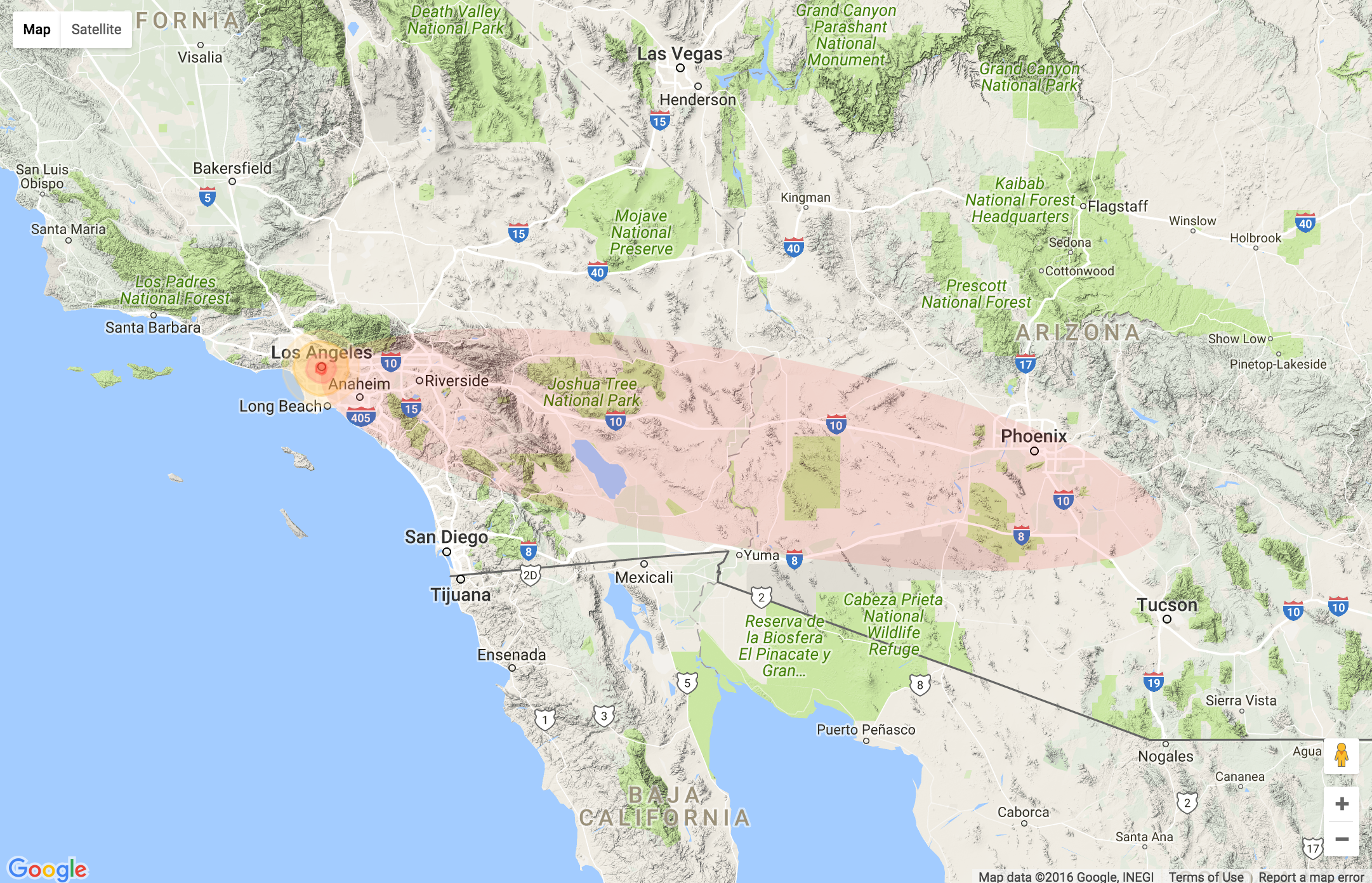
The fallout plume would extend 426 miles and irradiate over 30,000 square miles. Lethal fallout would reach all the way to Phoenix.
Again, one shouldn't put total confidence in the accuracy of fallout calculations. Per the above discussion, many variables will influence the actual result. That said, this is probably a good approximation. Certainly - should you find yourself anywhere to the east of LA following a nuclear strike - it's no doubt a good idea to seek shelter.
How long would you need to remain in your radiation-shielded basement? Well, here at least we have some good news: fallout decays rapidly. This decay rate can be calculated by the rule of seven: after the initial explosion radiation falls by one magnitude for every power of seven of hours elapsed. This means that 7 hours after the explosion fallout radiation will be 1/10 as high and after 49 hours (7 x 7) it will be only 1/100 as intense. Said another way, in about 2 days radiation readings will be 1% of their original levels.
Thus, barring extreme initial levels of radioactivity, most areas should be habitable again after a couple weeks. Granted, every other living thing in the area might be dead, but people themselves can survive should they shield themselves for the required length of time.
I chose a middle path, modeling an attack that hits a significant number of targets but doesn't involve all-out war using all weapons. I used Russian warheads in this attack, applying their known weapon yields to the targets most suitable for them. The result is a "mainstream" scenario.
How many warheads would be required in such an attack? And - more importantly - where would those warheads land?
There's a rich literature on nuclear targeting strategy. People have been talking about this topic for decades. But during all this time - not surprisingly - the actual exact targeting lists used by governments have been kept top secret. This changed in 2015 when the US released a document detailing how it would have attacked the Soviet Union early in the Cold War. It makes for bloody and unsettling reading.
Historically there have been two main nuclear strategies: counter-force and counter-value. With counter-force, the idea is to attack only military, war-making and governmental targets. The ostensible goal is to destroy the enemy's ability to wage war versus destroying the enemy himself. This doctrine stands in contrast to counter-value, where the strategy is to defeat the enemy by simply annihilating all their cities. For obvious reasons, counter-force is often held to be morally superior to counter-value.
However, as the document makes plain, reality is not so kind to these theoretical distinctions. Many military sites are close to cities. Hitting them effectively means hitting the city itself. Further, the definition of a military site is broader than you might think. For instance, a civilian airport can be used by miliary planes. Similarly any port can host a warship as well as a cargo ship. Thus airports and seaports are legitimate military targets.
"Government targets" is another broad brush. That translates into hitting not just every buried bunker, but also every provincial capital and significant government office. Finally, destroying war-fighting capability effectively means destroying economic capability. If you take that logic to its limit it soon becomes necessary to pulverize every significant urban center. And that's exactly what US war planners did.
In the funhouse mirrors world of nuclear strategy, all of this is perfectly logical. War is, after all, the mechanism by which you defeat your enemy. Incinerating the entire enemy population is an efficient and straightforward path to accomplishing this goal. Ghenhis Khan would have easily understood modern nuclear strategy.
Russian and Chinese nuclear plans remain state secrets, but there is no reason to think they are much different than US plans. It isn't likely that Russian and Chinese nuclear forces are targeted to land in the ocean somewhere. Further, given the arc of history, there isn't a lot of reason to be optimistic that good intentions and mercy will figure prominently in any nuclear exchange. More likely a "use them or lose them" mentality will take hold. And this will be magnified by the chaos and pure terror that will be the hallmarks of any nuclear exchange.
Thus I chose a strategy similar to that taken by the unclassified documents. Military and command targets are quickly hit in a first wave. This is followed by subsequent waves of attacks on government targets (such as state capitals) and economic infrastructure. The war takes place over a period of two hours.
In those 120 minutes every significant military base in the United States is destroyed, as are the largest 100 cities and every state capital. Significant seaports, airports, oil infrastructure and hydroelectric facilities are also struck, per the goal of destroying economic infrastructure.
I chose to be conservative with regard to other tactics. For example, I didn't hit nuclear reactors. A surface-burst on such a reactor would create a monstrous fallout plume that would dwarf anything a mere hydrogen bomb could accomplish. There are 66 such reactors in this country. A systematic attack on them would coat most of the continent with radioactivity. I assumed that military planners wouldn't be so unethical.
I also chose to be modest with regard to after-effects. My fallout estimates are purposively modest. Among other things, I made no attempt to estimate systemic effects from multiple surface-bursts at one location. If there are 10 100kt surface-bursts in one location (which would happen at some missile silo sites), I model that resulting fallout as resulting from just a single 100kt burst. I also made no attempt to model the levels of radioactivity in the plume itself. I felt such calculations gave the model a false precision. In reality the best we can do with fallout is an approximation and I wanted the simulation to reflect that fact. Similarly I make no provision for likely long term outcomes such as climate disruption and crop failures, runaway disease and mass-famine.
Yes, it's time to mess with LA again. Here's what the region would look like after the attack:
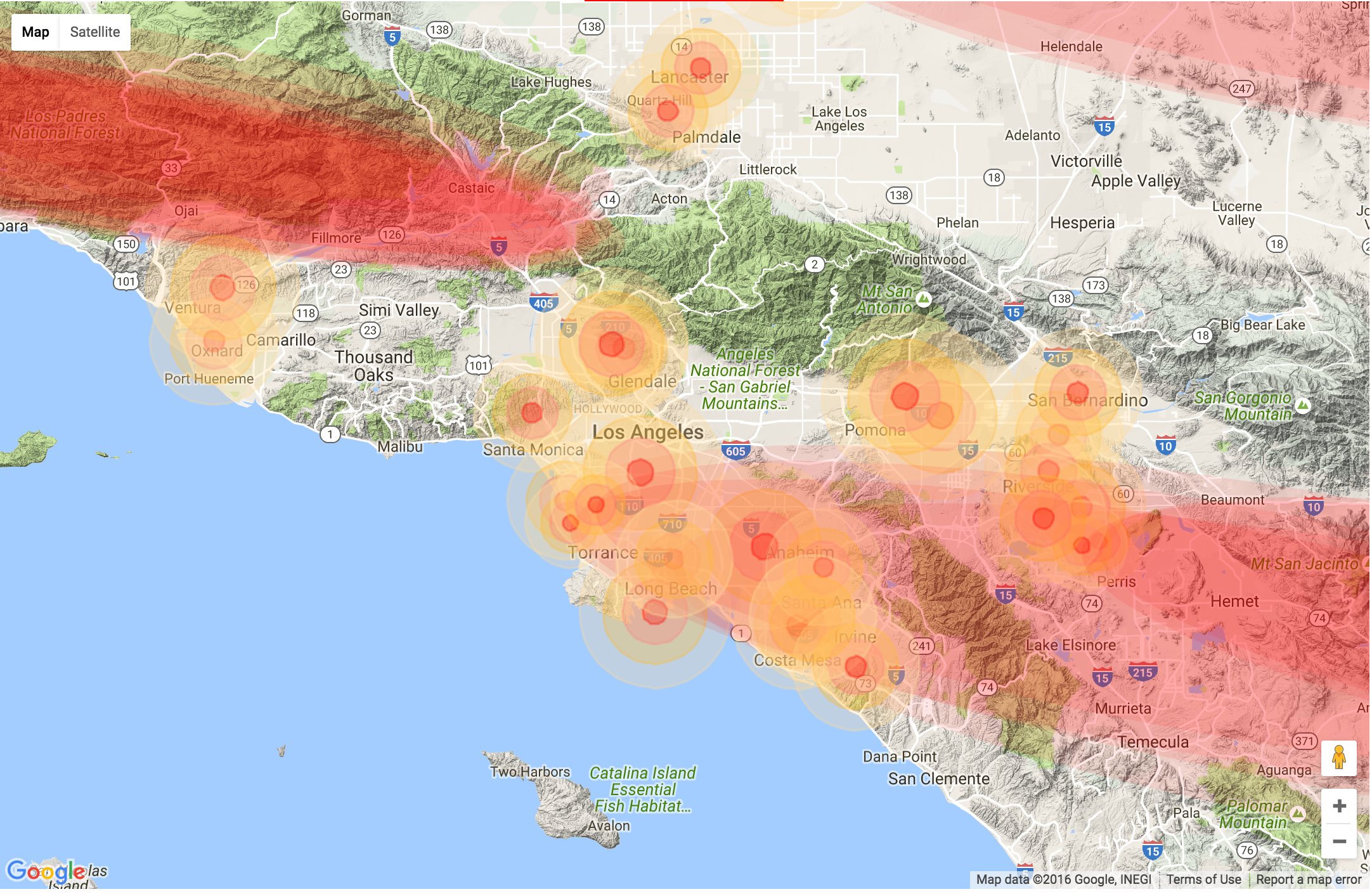
This is a simulated Russian attack. Therefore the good news is that the 5Mt Chinese Deng-Feng was not used. The bad news is that about two dozen other Russian warheads were used instead. These were sufficient to destroy every key economic center in the region, including the major container port in Long Beach. All military bases and major airports were wiped out as well.
To accomplish this the LA basin gets tiled with nuclear explosions. Very few areas escape the direct effects of the blasts and none escapes the overall consequences. Even those areas outside any burn rings will suffer from the resulting firestorms and radiation.
In this simulation the same attack pattern is repeated across the country. Every state is affected. In total somewhat less than 400 targets are hit. However, measured in other ways this is a rather modest attack. It requires less than 1100 warheads, which translates to about 15% of Russia's total nuclear capability. Things could go far worse.
Here is Little Boy over Hiroshima:
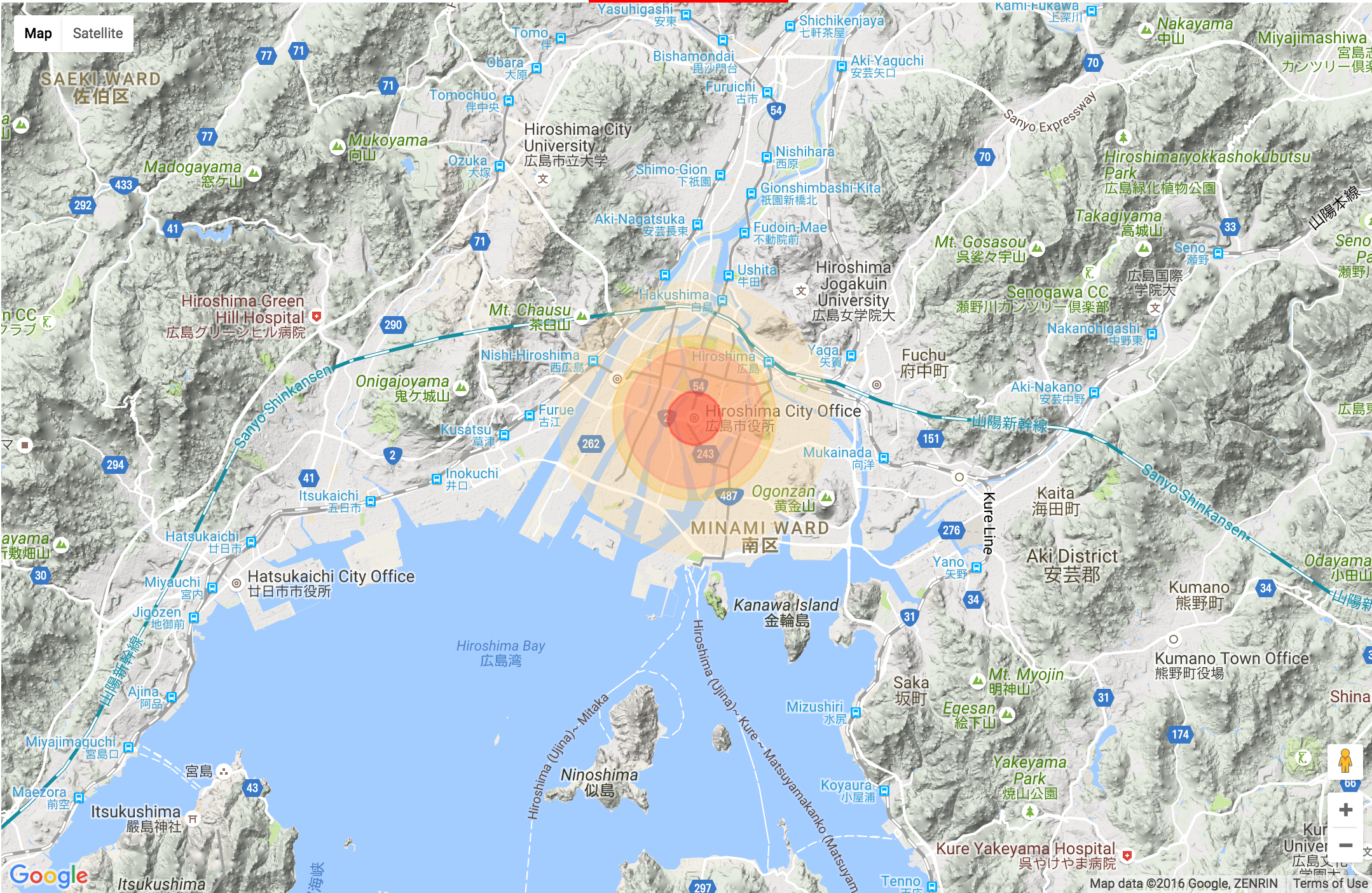
Hiroshima suffered 140,000 casualties out of a population of 340,000. That's roughly a 40% casualty rate. These numbers are often disputed, but this is a conservative lower-bound that is broadly accepted.
Using that as a starting point, we first observe that Little Boy affected less than half of the city. That is, most of the city was outside the outer ring of the explosion. Many people were able to retreat into those areas. Second, it's worth noting that help poured into Hiroshima immediately after the bombing. Outside the blast zone food and water supplies were not disrupted. There were still hospitals standing and doctors working. This meant that tens of thousands of injured people were able to get some basic supplies and medical attention. No doubt this saved many lives.
Here is Hiroshima being hit by a modern 500kt weapon:
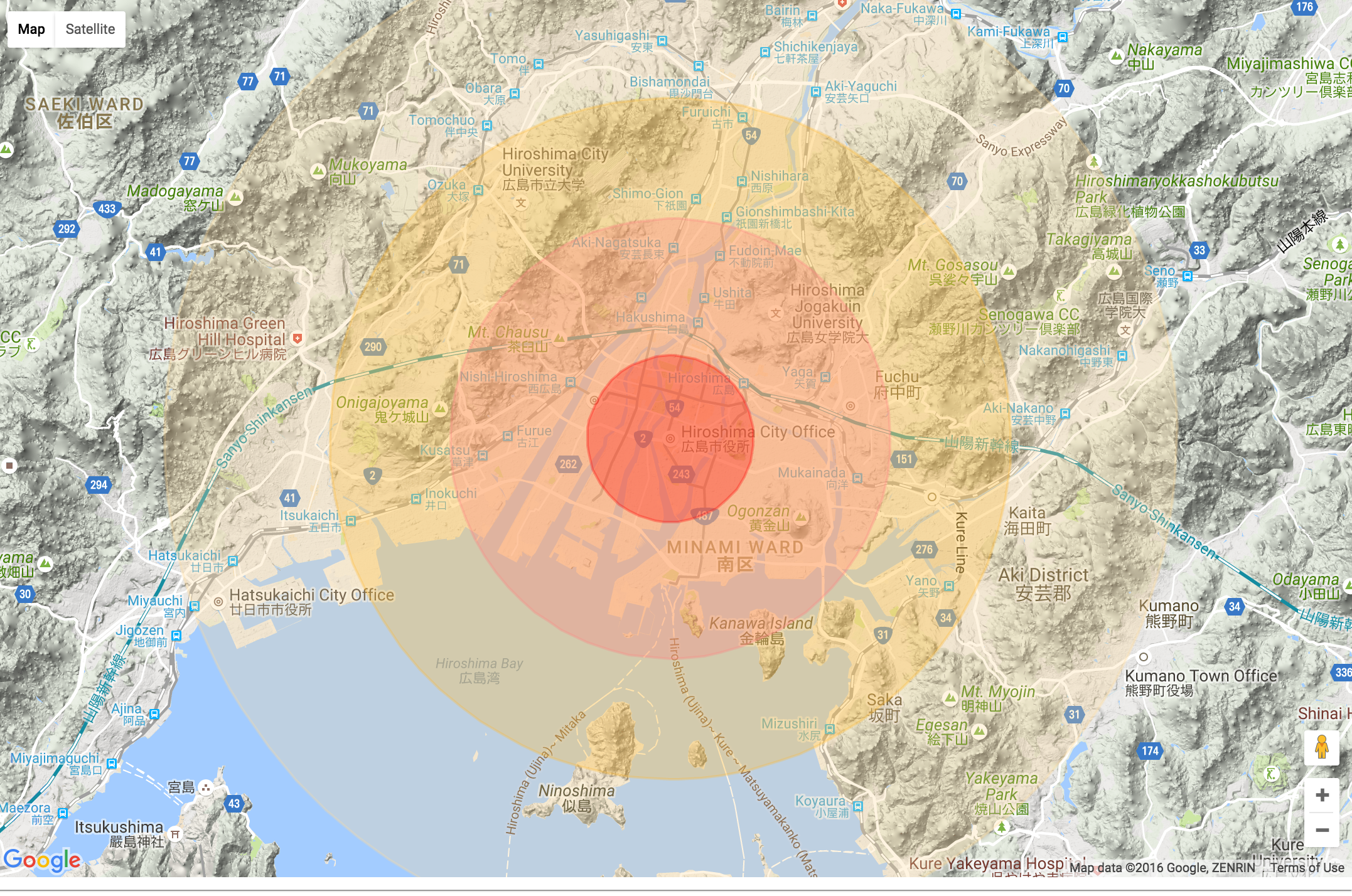
This modern warhead blankets Hiroshima with blast, heat and radiation. The entire urban area is affected. There would be no safe zones or places to retreat.
What would be the casualty rate? Taking the Hiroshima data and then mapping it into the known lethality rates of modern weapons, an 80% casualty rate looks reasonable. In other words, if Hiroshima were hit by a 500kt air-burst, there would minimally be 280,000 dead or wounded. Given all the population would be within the burn zone, I think this is a very modest lower-limit, particularly given the fact that this probably wouldn't be the only warhead detonating in the vicinity. Most likely there would be multiple local targets and therefore multiple interlocking target rings. Hiroshima would be annihilated.
In addition, there wouldn't be any hospitals left standing or even medical personnel to work in them, because every other urban area in Japan would be destroyed as well. Absent a working medical system the death rate would soar.
Thus 80% is our conservative base number. We can now apply this factor to our simulation. Every major urban region in the country would suffer an attack equivalent to LA, as would any city over 250,000 people and every state capital. Roughly 75% of the US population lives in these areas. Thus, if we take the 80% Hiroshima casualty rate and apply it to 75% of the population, we get a 60% overall casualty number.
This number doesn't account for casualties from purely military targets. Many of these targets are near cities anyway and thus will be counted in the overall totals. More remote bases have smaller numbers whose totals won't be impactful in any case. Therefore these are ignored.
Fallout will be a much bigger killer. No doubt millions will die as large parts of the country are irradiated. However, in order to be conservative and given the vagaries of fallout calculations, I don't include any calculations from this source. Thus this lower limit counts immediate bomb damage only and does not include any subsequent fallout casualties.
For the simulation, I took the 80% factor and applied it on pro-rata basis as each target is hit. Military targets are usually smaller and these get struck first. Thus in the simulation you will see casualty numbers ramp up slowly at first. Casualties then increase dramatically in the second hour of the war, as major cities are destroyed.
Rolling the numbers up, somewhat more than 180 million American are killed or injured in this war. Again, this is a cautious lower limit that doesn't take fallout into account. Most of these casualties will probably be deaths, given there will be little medical resources for the millions of severely injured.
Any survivors would face a critically damaged and hostile environment. Water, food, and fuel supplies would dwindle and then vanish. Millions of injured people would suffer and die due to the lack of medical infrastructure. Nor would there be any external help, as every other part of the country (and possibly the world) would be in the same dire situation. Absent a functioning government and society, survivors would be left to fend for themselves. Mass disease and starvation would be likely. Public order would probably collapse. The final overall mortality rate in such a post-attack world is truly impossible to estimate.
However the world remains generally unaware of this danger. The prevailing attitude is that nuclear war is an impossibility or a risk that somehow faded away after the Cold War. Meanwhile the danger builds and instability increases. Our species is standing at a precipice but is not even aware of it. That is a recipe for the ultimate tragedy.
I therefore created this website as a public service. I hope it will raise awareness.
© 2020 Christopher Minson